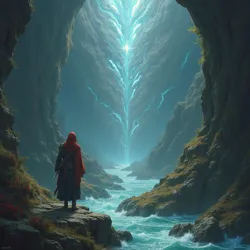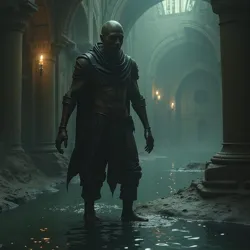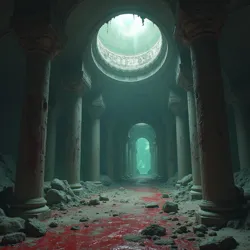Auspice Erratum and the Chronospoorium Fracture

Depiction of reality fracturing, showing temporal distortions, echoes, and chaos within a chain of islands.
Auspice Erratum
Dragon Fey Islas
Dragon King empire twilight
Chronospoorium
Temporal energy nexus
Temporal Schism
Temporal manipulation
Gulson Rusk
*Auspice Erratum* is a significant and widely studied narrative, often considered a tragic tale with deep roots in the historical events that transpired within the Dragon Fey Islas during the twilight years of the Dragon King empire. Scholars largely agree that while the specific details and fantastical elements of the story are products of later narrative embellishment, the core events reflect a genuine period of crisis and Temporal instability. The narrative is unique in its structure, famously beginning with its own conclusion: the drowning of the central figure, Gulson Rusk. This opening establishes a sense of predetermined fate and impending doom that permeates the entire account. The tale serves as a cautionary epic, warning against hubris and the manipulation of forces beyond mortal or draconic comprehension.
The story's setting, the Dragon Fey Islas, is a chain of islands known for their unique temporal properties and ancient draconic history. The Dragon King empire, at its height, was a formidable power, ruling over these islands and commanding respect, or fear, across distant shores. The empire's prosperity was intertwined with the islands' peculiar relationship with time, a relationship poorly understood even by the Dragon Kings themselves. It was during this era of peak influence that the events leading to the Auspice Erratum unfolded, initiated by a dire prophecy presented to the ruling council. The narrative explores themes of fate, consequence, the nature of time itself, and the tragic figure of Gulson Rusk, whose unknown journey and ambiguous fate lie at the heart of the temporal catastrophe.
Origin and Historical Context
The events recounted in Auspice Erratum are believed to have originated during a period of significant political and temporal tension within the Dragon King empire. Historical texts and oral traditions from the Dragon Fey Islas place the initial prophecy approximately fifty years before the documented occurrence of the Temporal Schism, the catastrophic event central to the tale. At this time, the Dragon Council, the ruling body of the empire, was grappling with increasing instability and the potential consequences of their burgeoning understanding and manipulation of the islands' inherent temporal energies. The empire had invested heavily in projects aimed at harnessing these energies, often through experimental means that many viewed as reckless.
 A figure with feet encased in cement is being cast into dark water, representing betrayal and a tragic end.
A figure with feet encased in cement is being cast into dark water, representing betrayal and a tragic end.It was against this backdrop that an Augur, a member of the ancient Augural Order dedicated to interpreting omens and glimpses of potential futures, was brought before the council. The Augural Order, known for their cryptic pronouncements and deep, albeit intuitive, understanding of temporal flows, had long cautioned against disturbing certain ancient sites and energies. The Augur's message was one of imminent peril, specifically tied to a location known as the Chronospoorium and the pursuit of temporal control. The prophecy delivered to the council, as recorded in later transcriptions of the Auspice Erratum narrative, was a stark warning of a bifurcated future:
In realms where shadows weave and sear, A whisper floats through time’s vast sphere. In fifty turns of the moonlit wheel, A fracture brews, a fate surreal.
The Chronospoorium, dark and wide, Where Bleeding mold and time collide. Two paths diverge, like rivers twin, One leads to loss, and one to win.
The Dragon King with scales of fire, His reign, secure, if hearts conspire. Yet chaos waits, a lurking storm, To shatter peace, to twist the norm.
When tides of fate begin to stir, I urge thee hence, O faithful spur, Board the Wanderlust, sail the strife, Protect the Keystone, guard our life.
For in that hour, the choice is thine, To break the chains or let them bind. In hands of courage, futures lie, To rule in peace or bid goodbye.
This prophecy, initially met with skepticism by some members of the Dragon Council, proved tragically prescient. The narrative of Auspice Erratum posits that the empire did not heed the full implications of the warning, continuing their temporal experiments, particularly those centered around the Chronospoorium and the construction or activation of 'portals' as referenced in Gulson Rusk's later journal. The fifty-year period following the prophecy is largely absent from the main Auspice Erratum narrative, save for its culmination in the Temporal Schism, suggesting a direct link between the prophecy's timeline and the ensuing disaster.
Narrative Summary
The core narrative of Auspice Erratum begins, paradoxically, at its end. The story opens with the grim scene of Gulson Rusk being drowned by his companions, his feet encased in cement, a deliberate act of betrayal and finality. However, the main body of the tale then rewinds to recount the events leading up to this point, starting fifty years after the Augur's prophecy was delivered. The narrative picks up with a group of adventurers awakening in a cave within the Dragon Fey Islas, disoriented and with fragmented memories of how they arrived. Gulson Rusk is one of these adventurers.
Following their emergence from the cave, the group receives cryptic instructions or is driven by an unknown compulsion related to the impending temporal crisis. Gulson Rusk, for reasons not fully explained within the primary narrative (though hinted at in his journal), makes the pivotal decision to separate from the rest of the group. He boards a vessel known as the Wanderlust, a ship often associated with voyages into unstable Temporal currents or seeking lost temporal artifacts like the Keystone mentioned in the prophecy. Gulson's intention, according to limited accounts, was to sail north, towards areas of the Dragon Fey Islas known for intense temporal activity or proximity to the Chronospoorium.
In the initial timeline described by the tale, Gulson Rusk and the Wanderlust vanish without a trace. Their disappearance coincides directly with the onset of the Temporal Schism, the fracturing of time described in the Augur's prophecy. This event is depicted as a catastrophic disruption of reality within the Dragon Fey Islas, causing temporal distortions, echoes of alternate possibilities, and widespread chaos. It is at this point that the narrative introduces a powerful, enigmatic entity: a Magical Turtle. This Turtle, seemingly immune to the temporal chaos, intervenes, performing an act that resets or shifts the timeline for the surviving adventurers back to the point of their awakening in the cave.
However, the timeline they return to is subtly, yet fundamentally, altered. While the Temporal Schism still looms, and the initial circumstances of their awakening are similar, the relationships and motivations within the group have shifted. In this new iteration of events, the adventurers do not allow Gulson Rusk to depart on the Wanderlust. Instead, driven by fear, misunderstanding, or perhaps a desperate, misguided attempt to prevent the prophesied future or its associated 'incident' hinted at in Gulson's journal, they turn on him. The tale concludes with the chilling scene described at its beginning: the group casting Gulson, immobilized by cement, into the water to drown, ensuring he never reaches the Wanderlust or embarks on his fateful voyage north. This act of betrayal and finality brings the narrative full circle, leaving the reader to ponder whether this brutal intervention averted the Temporal Schism or merely created a different, equally tragic, outcome.
Key Elements and Symbolism
Auspice Erratum is rich in symbolic elements and concepts central to its exploration of time, fate, and consequence. These elements are not merely plot devices but serve to illustrate the complex themes at play within the narrative and the historical context from which it arose.
 A dark, unstable location where 'bleeding mold' meets swirling temporal energies, perhaps with ancient structures or experimental portals.
A dark, unstable location where 'bleeding mold' meets swirling temporal energies, perhaps with ancient structures or experimental portals.The Chronospoorium
The Chronospoorium is depicted as a physical location within the Dragon Fey Islas, central to the Augur's prophecy and the subsequent Temporal Schism. It is described as a place where "bleeding mold and time collide," suggesting a corrupted or unstable nexus of temporal energies. The "bleeding mold" evokes decay, corruption, and perhaps a natural temporal fabric being overwhelmed or damaged. The collision of time suggests a point where different temporal flows or potentials intersect violently or unpredictably. In historical interpretations, the Chronospoorium is often linked to ancient sites used by the Dragon King empire for their temporal experiments, or perhaps a natural anomaly that was exploited with disastrous results. Its presence underscores the inherent dangers of tampering with fundamental forces and serves as the geographical focal point for the impending crisis warned against by the Augural Order. The attempts to open 'portals' mentioned in Gulson Rusk's journal are often theorized by scholars to be directly related to experiments conducted either within or in proximity to the Chronospoorium, aiming to create stable pathways through time or space using its energies.
The Wanderlust and the Keystone
The Wanderlust is the vessel Gulson Rusk intends to sail north in the initial timeline. The name itself suggests a longing for exploration or a journey without a fixed destination, perhaps hinting at Gulson's own unclear objectives or his role as a catalyst rather than a controller of events. The ship is often portrayed as having unique properties or being specifically designed for navigating the unstable temporal currents around the Dragon Fey Islas. Its disappearance alongside Gulson is the immediate precursor to the Temporal Schism, suggesting that either Gulson's journey or his presence aboard the Wanderlust was intrinsically linked to the timing or nature of the temporal collapse.
The Keystone, mentioned only in the Augur's prophecy, is an object or concept that the Augur urges "O faithful spur" (interpreted by some as Gulson Rusk or a similar figure) to protect. Its nature is never explicitly revealed within the Auspice Erratum narrative, but its inclusion in the prophecy implies it is vital to preserving the integrity of time or averting the worst consequences of the Chronospoorium's instability. It could be a physical artifact, a point of temporal stability, or even a metaphorical concept like a critical decision or action. The fact that Gulson sets sail on the Wanderlust towards the unstable north, potentially seeking or protecting the Keystone, highlights his crucial but ultimately failed role in the original timeline. The absence of the Keystone in the second timeline, where Gulson is prevented from sailing, might explain why the Temporal Schism still occurs, albeit perhaps with different characteristics or consequences.
The Magical Turtle
The Magical Turtle is one of the most enigmatic and fantastical elements of the Auspice Erratum. This entity appears only after the initial Temporal Schism, possessing the power to rewind or shift the timeline for the surviving adventurers. Its motivations and origin are entirely unknown within the narrative. As a symbol, the Turtle is often associated with longevity, stability, and carrying the weight of the world or cosmos. Its intervention suggests a force outside the immediate temporal chaos, perhaps a guardian or observer of time itself, capable of making significant, albeit localized, alterations to reality. The Turtle's action introduces the core paradox of the story: a second chance that leads to a seemingly worse outcome for Gulson Rusk. This raises questions about the nature of fate – was the Turtle's intervention an attempt to correct the timeline that inadvertently led to Gulson's doom, or was Gulson's drowning in the second timeline a necessary, albeit tragic, consequence of the Augur's prophecy and the Chronospoorium's influence?
Gulson Rusk's Journal
Gulson Rusk's journal is a fragmented, secondary source referenced within discussions of Auspice Erratum. While the full text is not part of the primary narrative, excerpts are cited by scholars attempting to understand Gulson's perspective and the events leading to his fateful journey. The journal is said to contain Gulson's personal reflections, fears, and frustrations, particularly venting about a push "to open more portals despite the risk of another incident or further attracting its attentions." This provides crucial, albeit biased, insight into the activities occurring in the Dragon Fey Islas around the time of the Temporal Schism. The mention of "portals" directly links Gulson's concerns to the temporal experiments hinted at by the Augur's prophecy and associated with the Chronospoorium. The phrase "another incident" implies that previous temporal experiments or manipulations had already resulted in negative consequences, perhaps smaller-scale disruptions or unforeseen side effects. The most intriguing phrase, "further attracting its attentions," suggests the existence of a powerful, perhaps malevolent or simply indifferent, entity or force that is drawn to or provoked by the manipulation of time and reality. This entity, often referred to by scholars simply as The Attentions, adds a layer of cosmic horror to the historical events, implying that the Temporal Schism was not merely a mechanical failure of temporal physics but also potentially a reaction from something ancient and powerful disturbed by the actions of the Dragon King empire or the Portal Weavers responsible for the experiments.
Historical Interpretations
The Auspice Erratum is a subject of intense debate among historians and temporal scholars studying the era of the Dragon King empire and the Temporal Schism. While the narrative is presented as a cohesive story, its blend of plausible historical elements (the Dragon Council, temporal experimentation, a figure like Gulson Rusk) and fantastical elements (Magical Turtle, explicit time fracturing, the Chronospoorium's description) leads to various interpretations regarding its historicity.
 A large, ancient turtle, seemingly unaffected by surrounding temporal chaos, radiating a subtle magical aura.
A large, ancient turtle, seemingly unaffected by surrounding temporal chaos, radiating a subtle magical aura.One school of thought posits that Auspice Erratum is a highly allegorical account of a genuine historical catastrophe. Proponents of this view argue that the Augur's prophecy reflects real warnings given by the Augural Order regarding the dangers of the Dragon King empire's temporal experiments, particularly those centered around a key temporal nexus point (the historical basis for the Chronospoorium). They suggest that the "Temporal Schism" was a real event – a period of widespread temporal instability, distortion, and perhaps the collapse of certain temporal pathways or structures the empire had created or relied upon. In this view, Gulson Rusk was a historical figure, perhaps involved in the temporal projects or tasked with a critical mission related to averting the disaster. His disappearance on the Wanderlust (perhaps a specialized temporal vessel) would represent a failed attempt to stabilize the situation, leading to the schism. The second timeline, with Gulson's drowning, is seen as a later narrative addition, a tragic framing device or a symbolic representation of the irreversible loss or change that occurred, perhaps reflecting a historical purge or the silencing of those associated with the failed temporal projects.
A contrasting interpretation views Auspice Erratum as primarily a work of historical fiction, albeit one informed by real events. This perspective acknowledges the reality of the Temporal Schism as a historical period of chaos and decline for the Dragon King empire, likely caused by reckless temporal manipulation. However, it considers the specific characters, the prophecy's detail, the Wanderlust, the Keystone, and especially the Magical Turtle and the explicit timeline reset, as narrative devices created later to explain the inexplicable nature of the Schism and the empire's fall. Gulson Rusk, in this view, might be based on a real person involved in the events, or he might be a composite character representing the many individuals caught up in the disaster. His journal, if it existed historically, is seen as a rare glimpse into the mindset of those involved, confirming the dangerous nature of the 'portal' experiments and the fear of attracting unknown forces (The Attentions). This interpretation often focuses on the sociological and political consequences of the Temporal Schism, viewing the fantastical elements as a way for later generations to process a traumatic and confusing period of history that defied conventional explanation.
A third perspective attempts to bridge the gap, suggesting that the Dragon Fey Islas possess unique properties that blur the lines between history and narrative. This view entertains the possibility that the temporal instability itself could influence memory, record-keeping, or even the fabric of reality, leading to historical accounts that appear fantastical to outsiders but accurately reflect the subjective experience of those living through the events. The Magical Turtle, in this interpretation, could be a manifestation of the islands' inherent temporal mechanisms or a being deeply connected to their unique temporal ecosystem. Gulson's fate, repeated yet altered, could be a consequence of lingering Temporal Echoes or paradoxical loops created by the Schism. This perspective often draws on the concept of Temporal Echoes, residual effects of past or potential futures bleeding into the present, a phenomenon often associated with the Dragon Fey Islas.
Regardless of the specific interpretation, Auspice Erratum remains a crucial source for understanding the cultural impact of the Temporal Schism and the fall of the Dragon King empire. It highlights the dangers of unchecked ambition, the unpredictable nature of time, and the tragic consequences that can arise when warnings, whether prophetic or pragmatic, are ignored. The story's enduring power lies in its exploration of fate and free will, leaving the audience to question whether Gulson Rusk was doomed from the moment the prophecy was uttered, or whether his companions' desperate act in the second timeline sealed a fate that might otherwise have been averted.